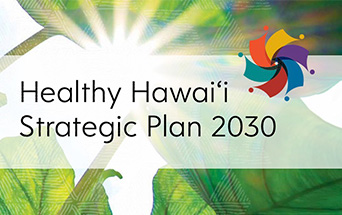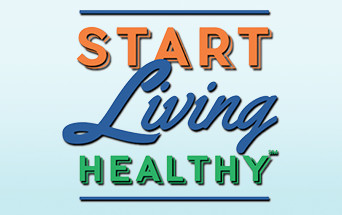School Health
School settings play an important role in helping children ages 5-18 establish foundational health behaviors and adopt lifelong health patterns. Schools provide optimal learning opportunities to improve educational and health outcomes for young people through advances in policy, environmental, and systems changes. Partnerships between the Department of Health (DOH), the Hawaiʻi State Department of Education (HIDOE), state and county agencies, and other community partners are vital to promote nutrition, physical activity, and tobacco-free lifestyles with our keiki.
Improving School Health
Local School Wellness Policy
Every Local Education Agency (LEA) that participates in the National School Lunch Program or other federal child nutrition program is required by law to establish a local school wellness policy for all schools under its jurisdiction. Local wellness policies help to promote student wellness and ensure school meal nutrition guidelines meet the minimum federal school meal standards.
The Hawai‘i State Board of Education Policy 103-1 Health and Wellness, sets forth that HIDOE shall establish guidelines to ensure compliance with federal school wellness regulations.
Wellness Guidelines
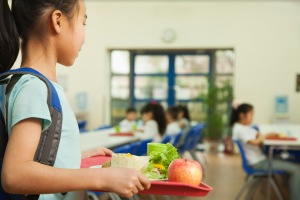 The Wellness Guidelines implement the Board of Education’s local school wellness Policy 103-1 and fulfill the requirements of Public Law 108-265 Section 204 and the Healthy Hunger-Free Kids Act of 2010. Representative stakeholders from the DOH, HIDOE, and community agencies across the state provided input in the 2007 development and 2017 revision of the Wellness Guidelines. The Wellness Guidelines support a healthy school environment through nutrition criteria for food and beverages that are sold or made available on a school campus, goals for nutrition education, health education, physical activity, physical education, and wellness-focused professional development for staff.
The Wellness Guidelines implement the Board of Education’s local school wellness Policy 103-1 and fulfill the requirements of Public Law 108-265 Section 204 and the Healthy Hunger-Free Kids Act of 2010. Representative stakeholders from the DOH, HIDOE, and community agencies across the state provided input in the 2007 development and 2017 revision of the Wellness Guidelines. The Wellness Guidelines support a healthy school environment through nutrition criteria for food and beverages that are sold or made available on a school campus, goals for nutrition education, health education, physical activity, physical education, and wellness-focused professional development for staff.
The Wellness Guidelines act as a tool for parents and the school community, and present evidence-based guidance in connection with the Whole School, Whole Community, Whole Child (WSCC) model [https://www.cdc.gov/healthyschools/wscc/index.htm] for establishing healthy school environments that promote student healthy eating, physical activity, and wellness. Schools play an important role in championing wellness and positive, foundational health behaviors.

School Health Surveys
Safety and Wellness Survey
The Safety and Wellness Survey (SAWS) was developed to assist with the implementation and monitoring of the Wellness Guidelines. This annual online survey is jointly administered by the DOH and the HIDOE and is completed by public school principals statewide. It’s used to assist schools in measuring their progress towards a greater culture of health and wellbeing. Click to view the latest Safety and Wellness Survey results.
Youth Risk Behavior Survey
The Youth Risk Behavior Survey is part of a national CDC-supported surveillance system that measures teen health risk behaviors and experiences that contribute to the leading causes of death and disability among youth, including: unintentional injuries and violence, mental health and suicide, tobacco use and vaping, alcohol and other drug use, sexual behaviors related to unintended pregnancy and sexually transmitted infections, weight and nutrition, physical activity, and protective factors. The YRBS results help monitor health trends, identify emerging issues, and is used to plan and evaluate programs that can help improve adolescent health.
The YRBS is administered biennially through a partnership between the HIDOE, DOH, and the University of Hawai‘i’s (UH) College of Education (COE). The Hawai‘i School Health Survey (HSHS) Committee, an advisory consortium with representatives from diverse state agencies, contributes to the YRBS questionnaire development, consultation and review of results prior to public release, and communication and distribution of the YRBS results. YRBS data is protected by security and privacy laws, including the Family Educational Right Privacy Act (FERPA) and other HIDOE and DOH policies.
YRBS custom data reports, questionnaires, and data user guides can be found here.
Additional infographics from the national Youth Risk Behavior Survey can be found here.
Promoting Healthy Behaviors
Farm to School
Farm to School programs connect students and communities with nutritious local foods, local food producers, and garden education. Farm to School strengthens the local economy, improves the health of communities, and sustains community food systems. Farm to school includes the following core elements:
- Education: Students participate in education activities related to agriculture, food, health or nutrition;
- School Gardens: Students engage in hands-on learning through gardening; and
- Procurement: Local foods are purchased, promoted, and served in the cafeteria as a snack, or taste test.

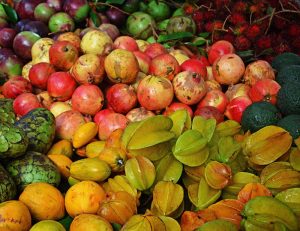
Let’s Talk About …
The “Let’s Talk About …” series of infographics was developed by the Hawaii School Health Survey Committee as a user-friendly resource for educators and other adult-allies of youth, who are having important conversations with children, adolescents, and young adults to address some of the critical health concerns in Hawaii. Information is from the Hawaii Youth Risk Behavior Survey and other local data sources.
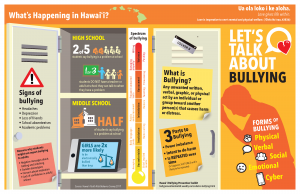 |
Download Bullying Infographic
11″ x 17″ PDF (427 kb) |
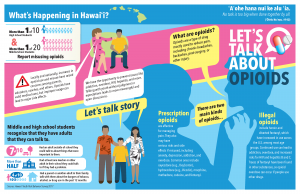 |
Download Opioids Infographic
11″ x 17″ PDF (427 kb) |
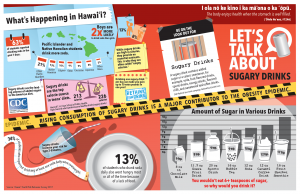 |
Download Sugary Drinks Infographic
11″ x 17″ PDF (1.95 mb) |


